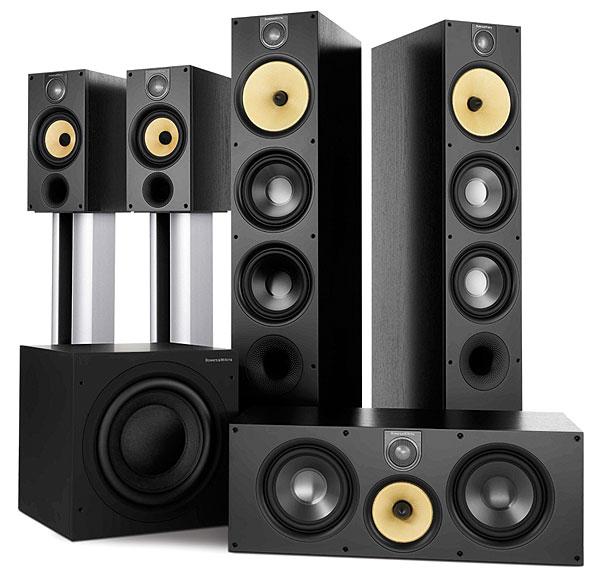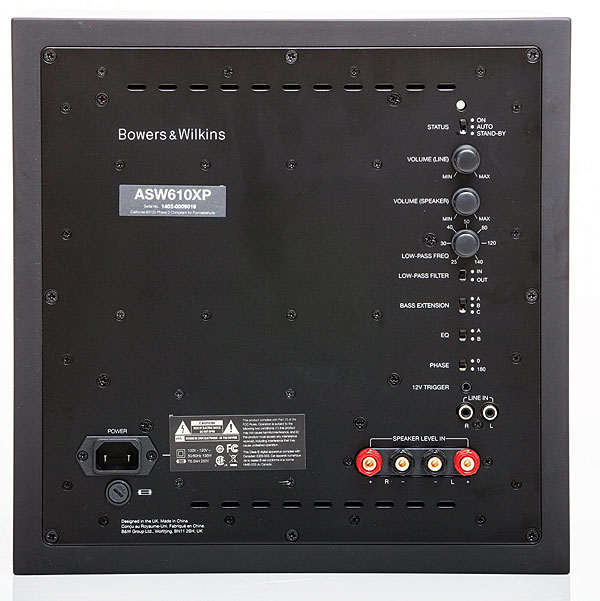I purchased a full 600 series 1 surround set-up in the mid 1990's so I am not sure what "Original 600 series" this guy reviewed 6 years ago.
Bowers & Wilkins 683 S2 Speaker System

AT A GLANCE
Plus
Soundstaging
Presence and immediacy
Tight bass (with
subwoofer)
Minus
Top end a bit restrained
Limited subwoofer output
Pedestrian styling
THE VERDICT
It took some effort to get their best in my room, but these relatively affordable B&Ws ultimately came through with a big, immediate, and generous sound.
Bowers & Wilkins, aka B&W, has been in the loudspeaker game since the mid-1960s. I reviewed the company’s original 600 series for Stereophile Guide to Home Theater over six years ago, and I was impressed—even though I was listening to those speakers immediately after evaluating Revel’s high-end Ultima2 system. At less than 15 percent of the Revels’ price, the B&Ws couldn’t, of course, equal them. But they weren’t anywhere near embarrassed by the comparison. Now we have the 600 S2 models in house, ready to do battle. The Revels are no longer here, of course, so the 600 S2s will have to speak for themselves. We’re ready to see if they can.
Something Old, Something New
Both the 683 S2 floorstander and the HTM61 S2 center speaker are three-way designs. They employ B&W’s classic, yellow woven Kevlar FST (Fixed Suspension Transducer) midrange drivers to cover the range from 400 hertz to 4 kilohertz. Since little cone movement is needed above 400 Hz, the FST ’s woven Kevlar cone is kept centered by a ring of foam around its perimeter rather than by the conventional flexible surround—a technique said to reduce distortion. The FST in the 683 S2s is 6 inches, and theory suggests that for a driver of this size, 4 kHz is a little high for a low-pass crossover. (The dispersion of a cone driver decreases with increasing frequency.) But B&W has consistently used this crossover point in its current and past FST midranges, even in the top-of-the-line 800 Diamond series. The FST in the HTM61 S2 is smaller, at 5 inches.
The woofers in both of these models have dual-layer aluminum cones. But the major change in the 600 S2 lineup is the addition of the so-called Double Dome tweeter, originally designed for B&W’s more upscale CM10. It consists of a light, thin dome in the center, surrounded by a ring of thicker material. The intention is to improve the dome’s overall rigidity, reducing distortion. In addition, gel mounting pads isolate the tweeter from cabinet vibrations. The two-way 685 S2 monitor also includes the Double Dome tweeter. Its bass cones are fashioned from the same woven Kevlar material used in the FSTs.
All of the above speakers are ported. B&W supplies foam plugs (or bungs, as the Brits call them), which can be left out or used to either fully or partially block the ports. The optimum configuration will depend on the placement of the speakers; the closer they are to a nearby wall, the more likely you’ll find the plugs beneficial.
The ASW 610XP subwoofer’s sealed cabinet isn’t much larger than its 10-inch, paper/Kevlar-coned driver, which is powered by a 500watt amplifier (no conditions-of-test specified). The on/off switch has an auto-sensing mode. The sub’s controls include a variable (and defeatable) low-pass filter (fourth order), level controls (one each for the line- and speaker-level inputs), and a two-position (0 and 180 degrees) phase control. There’s also an EQ switch for the sub’s bass rolloff alignment: A, for corner placement (a faster rolloff), and B, for placement away from corners. A Bass Extension switch offers three positions for a (claimed) –6-decibel output: 18 Hz (A), 23 Hz (B), and 28 Hz (C). You must redo your level calibration when using this switch; there’s a drop of several decibels in the sub’s output as you step down from A to B to C.
All of the full-range 600 S2s here have dual binding posts for biwiring or biamping, if desired. They’re available only in a black, oak-grained vinyl (solid black for the sub).
Setup
I placed the 683 S2s in my 15.5 x 27 x 8-foot home theater at the left and right of my 96-inch-wide projection screen (retracted during music listening), about 6 feet out from a short wall, a minimum of 2.5 feet from the closest side wall, and angled in toward the center seat. The included spikes, feet, and grilles weren’t used. I put the HTM61 S2 center on a short B&W center stand just beneath the screen. The pair of 685 S2 monitors, used here as surrounds, were on stands near the back of the room.
The ASW 610XP subwoofer was in the right front corner of the room. I first set the Bass Extension switch in position A (maximum extension), with the EQ switch also in position A (for the corner location) and the low-pass filter disengaged (the high- and low-pass crossovers were performed in the surround processor).

Besides the Integra DTC-9.8 surround processor, the review system included, initially, a Parasound Halo A 51 power amp. The cables, most of them vintage, were from Monster Cable, AudioQuest, Cardas Audio, Acoustic Research Master Series, and Kimber Kable. The Blu-ray players were an Oppo BDP-105D (movies) and a Marantz UD7006 (music). For music listening, I sat centered about 10 feet from the plane of the front speakers; for movies, I sat to the left of center and slightly further back.
Music
In two-channel mode, without the ASW 610XP subwoofer, the 683 S2s produced a solid soundstage with crisp, well-defined left-to-right imaging. They did sound a bit forward, but not excessively so, with solo voices and instruments offering a solid, almost you-are-there presence. At first I found the top end a little softer than ideal in my room, but that was likely in comparison with the brighter Monitor Audio Silver 10s ($2,500/pair) I had just finished reviewing for soundandvision.com.
The 683 S2s never quite made me forget the alacrity with which the Monitor speakers had handled the leading edges of fine, high-frequency detail (without excessive brightness). Nevertheless, I came to appreciate the unassuming naturalness of B&W’s new Double Dome tweeter. I did, however, make a few system adjustments to get the best from it. The 683 S2’s tweeter sits about 4 inches above my ear height, so I tilted the speakers forward slightly. For hooking up the surround processor to the amp, I changed the interconnect cables from the more laid-back Cardas Hexlink 5s to a set of AR Master Series. I also swapped my long-term reference Parasound amp for an older, less pricey (when available) Outlaw 750. The latter is less refined and punchy than the Parasound but also slightly brighter, which helped further liven up the B&Ws’ sound.
I also tweaked the Integra’s tone and manual EQ controls, but these adjustments were small and produced no more of a change than what you might expect in a different, slightly more lively room (my room is well damped). I didn’t use the Integra’s available Audyssey equalization.
- Log in or register to post comments


I'm with sathishadht with this B&W package. The good value-for-money claim just can't be made for this setup according to the average consumer's standards. Of course, even if I was in the habit of buying much more expensive equipment I still don't see the value.
The response of the speakers is ragged for the price. The sense of dynamic range is fine for movies but if it lacks the upper midrange/lower treble attack on the leading edge of high-end transients, this would be very obvious when listeners are focused on percussion-laden music.
At the price, response should be a hell of a lot flatter for the ensemble and the subwoofer's performance should be better. Hopefully, this isn't part of a trend for B&W.




































































